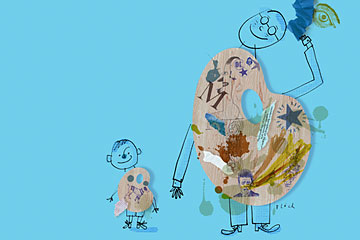
(3 of 6)
"We're like a jumbo jet that's always getting repairs and new parts," says Bartzokis. The key to qualifying for that servicing, however, is remaining mentally active. Just as you can't build muscle mass without working your body, you can't grow new myelin--or at least enough of it--without working your brain. "When you use your brain a lot as opposed to sitting around looking at the wall, you're repairing things centrally," Bartzokis says.
Not all intellectual functions are preserved in older people. Age can be murder on what's known as fluid intelligence--which involves working memory, computing speed, the ability to hold multiple ideas in the mind at once. That hits certain skills harder than others. Mathematicians, physicists and chess players tend to do their greatest work when they're in their 20s and 30s since all of those disciplines require just the kind of agile, fast-clicking brain that's characteristic of those ages. It's the same reason too that kids acquire languages, master computers and video games and work puzzles like Rubik's Cubes so much better than older people.
Still, to the extent that the brain's processing power does decline, it compensates in other ways--ones that actually enhance creativity. In a younger brain, work is fairly well lateralized--with certain functions, like language, taking place in the left hemisphere and other functions, like spatial reasoning, playing out in the right. Studies with functional magnetic resonance imaging (fMRI), however, show that in the older brain, one hemisphere is not shy about calling on the other for help if it's having trouble with a task. "There may be a decline in function, but it's partly compensated for by a reorganization in function," says cognitive neuroscientist Roberto Cabeza of Duke University. "The brain shows these changes into the 80s."
That can pay particular dividends for the artist, Cabeza says. Take the metaphor--one of the writer's prettier devices and one of the brain's niftier tricks. Language conveys meaning, but if you want to give it particular resonance, it helps to attach a picture to the words. So the left brain has to reach into the right for help--the poet borrowing one of the painter's brushes. That's not easy to do--which is why not everyone can be a poet--but when the walls between the hemispheres get lower, the job gets easier.
Other kinds of insights and inspiration benefit from getting the hemispheres talking to each other. Neuroscientist Lisa Aziz-Zadeh of USC, who studies the brain and creativity, has conducted experiments in which subjects are slid into an fMRI machine while they solve scrambled-word puzzles. As anyone who has tried to unjumble a string of letters like LREFWO knows, sometimes the answer just jumps out at you (flower!) and other times you have to reason your way through it--try the L as the first letter, then the F, then the O, until you figure it out. And it's also clear which way feels better: it's the sudden insight, by a lot. "These moments feel really good. They feel amazing," says Aziz-Zadeh.
